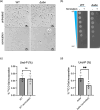Sequestration of dead-end undecaprenyl phosphate-linked oligosaccharide intermediate
- PMID: 39888664
- PMCID: PMC11784914
- DOI: 10.1099/mic.0.001530
Sequestration of dead-end undecaprenyl phosphate-linked oligosaccharide intermediate
Abstract
Most Gram-negative bacteria synthesize a plethora of cell surface polysaccharides that play key roles in immune evasion, cell envelope structural integrity and host-pathogen interactions. In the predominant polysaccharide Wzx/Wzy-dependent pathway, synthesis is divided between the cytoplasmic and periplasmic faces of the membrane. Initially, an oligosaccharide composed of 3-8 sugars is synthesized on a membrane-embedded lipid carrier, undecaprenyl pyrophosphate, within the cytoplasmic face of the membrane. This lipid-linked oligosaccharide is then translocated to the periplasmic face by the Wzx flippase, where it is polymerized into a repeat-unit polysaccharide. Structural alterations to the O-antigen repeating oligosaccharide significantly reduce polysaccharide yield and lead to cell death or morphological abnormalities. These effects are attributed to the substrate recognition function of the Wzx flippase, which we postulated to act as a gatekeeper to ensure that only complete substrates are translocated to the periplasmic face. Here, we labelled Salmonella enterica serovar Typhimurium group B1 with [14C] d-galactose. Our results showed that strains unable to synthesize the full O-antigen repeat unit accumulate significantly higher levels of Und-P-linked material (~10-fold). Importantly, this sequestration is alleviated by membrane disruption which opens the lipid-linked oligosaccharide at the cytosolic face to periplasmic ligation to support accumulation occurs at the cytosolic face of the membrane.
Keywords: O-antigen; Wzx flippase; polysaccharide; substrate fidelity; substrate preference; undecaprenyl phosphate.
Conflict of interest statement
The authors declare that there are no conflicts of interest.
Figures



Similar articles
-
Three Wzy polymerases are specific for particular forms of an internal linkage in otherwise identical O units.Microbiology (Reading). 2015 Aug;161(8):1639-1647. doi: 10.1099/mic.0.000113. Epub 2015 May 18. Microbiology (Reading). 2015. PMID: 25987464
-
The Wzx translocases for Salmonella enterica O-antigen processing have unexpected serotype specificity.Mol Microbiol. 2012 May;84(4):620-30. doi: 10.1111/j.1365-2958.2012.08048.x. Epub 2012 Apr 13. Mol Microbiol. 2012. PMID: 22497246
-
Repeat-Unit Elongations To Produce Bacterial Complex Long Polysaccharide Chains, an O-Antigen Perspective.EcoSal Plus. 2023 Dec 12;11(1):eesp00202022. doi: 10.1128/ecosalplus.esp-0020-2022. Epub 2023 Jan 9. EcoSal Plus. 2023. PMID: 36622162 Free PMC article. Review.
-
Wzx flippase-mediated membrane translocation of sugar polymer precursors in bacteria.Environ Microbiol. 2013 Apr;15(4):1001-15. doi: 10.1111/j.1462-2920.2012.02890.x. Epub 2012 Sep 27. Environ Microbiol. 2013. PMID: 23016929 Review.
-
Progress in Our Understanding of Wzx Flippase for Translocation of Bacterial Membrane Lipid-Linked Oligosaccharide.J Bacteriol. 2017 Dec 5;200(1):e00154-17. doi: 10.1128/JB.00154-17. Print 2018 Jan 1. J Bacteriol. 2017. PMID: 28696276 Free PMC article. Review.
Cited by
-
Tolerance mechanisms in polysaccharide biosynthesis: Implications for undecaprenol phosphate recycling in Escherichia coli and Shigella flexneri.PLoS Genet. 2025 Jan 30;21(1):e1011591. doi: 10.1371/journal.pgen.1011591. eCollection 2025 Jan. PLoS Genet. 2025. PMID: 39883743 Free PMC article.
References
MeSH terms
Substances
LinkOut - more resources
Full Text Sources

